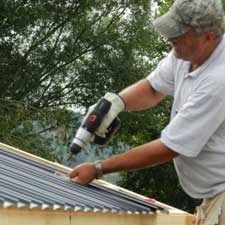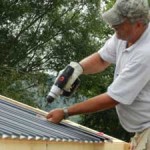My maternal great-grandparents purchased a cabin on Newman Lake, Washington from its original owner/builder in 1937. Nine years later, it was sold by them to their son and his wife – my grandparents Boyd and Jerene McDowell. A little over thirty years ago, I inherited this cabin from them. Having grown up spending most of my summers there, I envisioned turning this cabin into a year-around home.
This cabin’s original hand split cedar shake roofing (on a 7/12 slope over 1x skip sheeting) had been replaced once, by my father – and we enjoyed using these original shingles as fire starter for many years. This second roof was then again replaced with Cocoa Brown polyester painted thru-screwed steel. Polyester paint, while certainly a step up from bare galvanized, did not maintain its original luster for long (for extended reading on Polyester paint: https://www.hansenpolebuildings.com/2014/05/polyester-paint/).
As my vision involved significant remodel work, we opted to change roofing to a SMP paint (https://www.hansenpolebuildings.com/2014/05/smp/) with an actual fade and chalk warranty. Through a series of events, our remodel schedule had to be moved forward from its originally intended Spring start, to doing work in Winter. Again (keep in mind), in Northeast Washington. Of course, as luck would have it, reroofing coincided with bitter cold and snow showers – resulting in speed of installation becoming of utmost importance. While I did much work myself, I had an assist from a casual labor wrangler appropriately known as “Big Kevin” who would round up day labor as needed. This reroof required some of these extra bodies.
 Fast forwarding a few years, I found some steel roof thru-screws were “backing out”. Upon careful examination, I found out why – in a hurry to get roofing installed, Big Kevin’s casual help had decided it would be quicker to pound screws in with a hammer (as could be evidenced by damage to screw heads)!
Fast forwarding a few years, I found some steel roof thru-screws were “backing out”. Upon careful examination, I found out why – in a hurry to get roofing installed, Big Kevin’s casual help had decided it would be quicker to pound screws in with a hammer (as could be evidenced by damage to screw heads)!
When screws are either over driven (or beat in by hammer), it damages wood fibers reducing or virtually eliminating their holding power. There was a solution – replacing these #9 diameter screws with larger #14 screws. These larger diameter screws, installed properly, were then able to get a firm bite into undamaged wood.
Using an actual screw gun (rather than a drill motor) with a clutch prevents most instances of over driving screws. Should a screw inadvertently be over driven, there is a quick field fix. All it takes is a short 2×4 and a table saw. Cutting with grain of wood, make a series of cuts in both directions to leave 1/8” squares remaining when looking at the 2×4 end. Turning to cut cross grain, chop these off in one-inch increments. This results in what appears to now be headless match sticks (albeit from much stronger lumber). Remove any offending screws and carefully drive a 1/8” square by an inch ‘plug’ into the screw hole in the underlying purlin. A screw can then be replaced into a plug filled hole, where it will happily remain in place.
Tag Archives: reroofing
My grandparent’s lake cabin was nearly 75 years old when the cedar shake roof finally gave out in the 1980’s. With the quality of cedar shakes down and the price high (besides the dangers of a wooden roof in a forest) the solution became clear – painted steel. In the woods, the non-combustible feature alone made for a hands-down winner.
Over 25 years later the steel roofing is still doing the job. Also, in the years since, five of the immediate neighbors have reroofed, all except one of them with steel. The one with shingles, well they are going to be reroofing in the not too distant future!
 Steel roofing has grown in popularity in the last few decades. It can be applied to virtually any surface, slope or roof style. Steel sheds snow, rain and windborne debris better than any other roofing material. Its light weight per square foot minimizes the structural costs to support and makes it relatively easy to work with. Aesthetically steel roofing offers the “designer look” along with function, beauty and long-term economy.
Steel roofing has grown in popularity in the last few decades. It can be applied to virtually any surface, slope or roof style. Steel sheds snow, rain and windborne debris better than any other roofing material. Its light weight per square foot minimizes the structural costs to support and makes it relatively easy to work with. Aesthetically steel roofing offers the “designer look” along with function, beauty and long-term economy.
When I first became involved in the pole building industry over 30 years ago, factory pre-painted steel was yet somewhat of a novelty. Almost all steel roofing was bare galvanized. Paint colors were fairly limited to Red, White, Blue, Green, Gold, Beige and Brown. We’d order standard lengths of White steel in massive quantities, at a discount, offering White painted roofs at the same price as bare Galvanized. Nowadays, twenty or more colors are available.
Early painted steel was polyester. Kind of like my ’66 Chevelle SS, it faded from Dark Blue to Robin’s Egg Blue in a matter of a few short years. Paint systems with more durability and slower fade rates are now available, from Silicon Modified Polyesters (SMP) to Kynar. I kind of think of Kynar as being as close to colored Teflon as you can get.
For practical purposes, under most atmospheric conditions, pre-painted steel will outlive the owner of the building!
Asphalt shingles may come with long warranty periods, but they are prorated against the original cost of the material and do not include any labor costs. Shingles are susceptible to damage in hail storms, especially at low temperatures.
Steel roofing will not rot, crack, split, warp, creep, curl, peel or erode. Tile roofing can break, and if so, how many people have kept a spare tile or tiles around and left them exposed to the weather so they will color fade the same? Wood shakes become waterlogged and the new building codes require them to be installed over asphalt impregnated paper (felt) which reduces their lifespan.
Reroofing? Steel roofing can be installed over most existing roofing without the need for structural modifications. This can eliminate costly tear-offs and disposals.
My grandpa Pete was a builder and owned a saw mill, my Dad and his five brothers were framing contractors. I was brought up with “wood is good”, but after three plus decades of using steel roofing, I am a convert!






